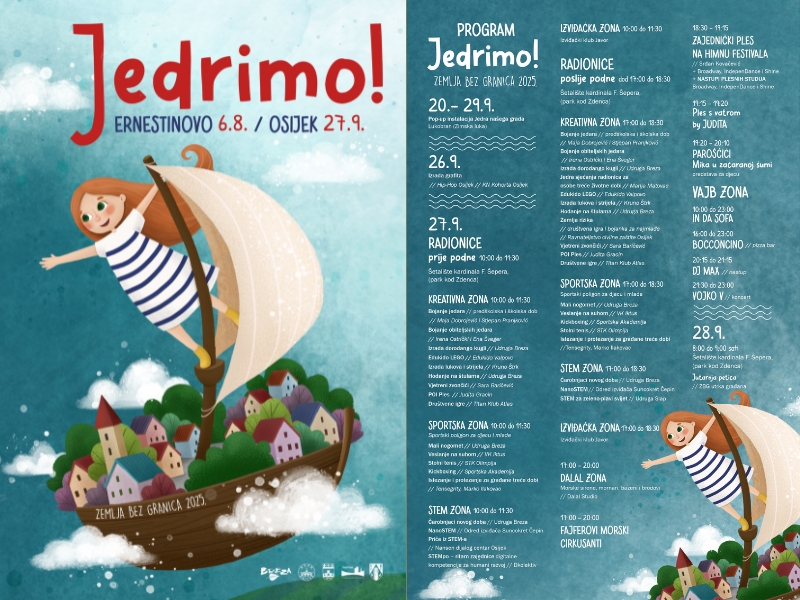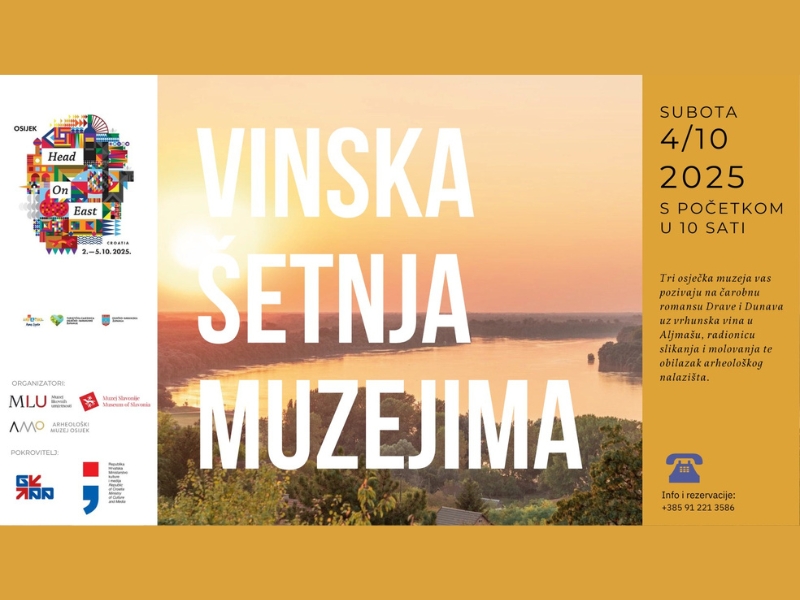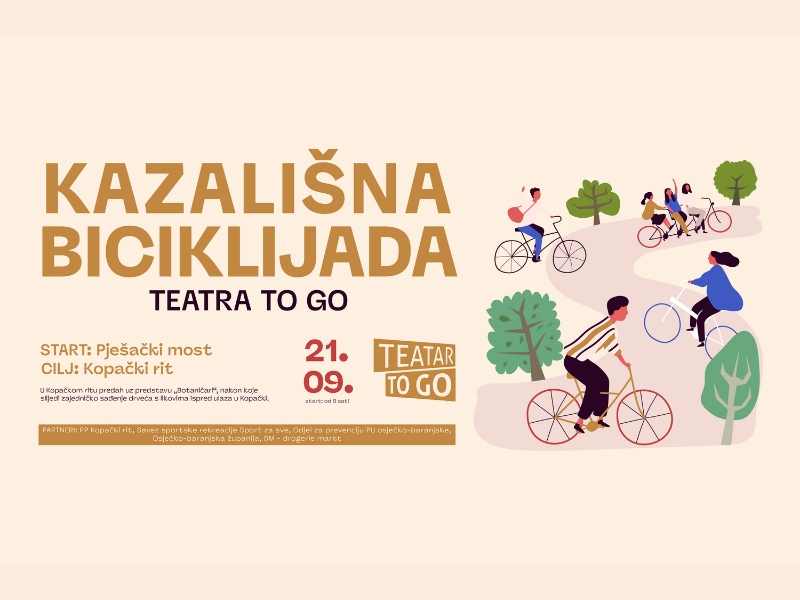Attractions

FERRY “KOMPA”
When you're in Osijek and you want to go across the river Drava you have two options. You can do it by walking across the legendary suspension "Bridge of youth" or by ferry "Kompa". Kompa began operating in 1916 and not driving with it from side to side of the river would be like visiting the city of Zagreb and not riding on the funicular. In addition, Kompa is a favorite mean of transportation to the citizens of Osijek when they are visiting the zoo and the beautiful park that surrounds it. Another reason for using the ferry is recreation. Cycling, skating or walking down the promenade along the river Drava is unimaginable without the use of this interesting and ecological vessel. Ferry is run only by the current of the river Drava and to avoid it from sailing downstream to the nearby Danube it's "firmly adhering" to the steel cable that comes from the mines in distant Carpathians.

THE ZOO
Osijek Zoo was founded in 1955. Thanks to its location away from the city noise it is a perfect place for a quiet stay for about 80 species of animals in cages and open houses. In the aquarium and terrarium lives another 20 species of fish and reptiles and the park has in total 650 specimens of animals. With the area of 11 hectares the Osijek Zoo is one of the largest parks in the Middle Danube region and a large value of the park is in its location. If after one visit you think that you have seen it all, you will surely want to visit it again and just enjoy the peace and quiet of unspoiled natural forest of Danube region. Next to the zoo there's the Hotel Zoo, a restaurant and children's playground. With a view of the river Drava and surrounding countryside this is certainly one of the most beautiful places to relax and "recharge the batteries" in the city.

MILL - WATER MILL
A very interesting vessel, mill-boat, stands near the ferry "Kompa", old Water-plant and the viewpoint over the river Drava .Tradition of mills on the river Drava dates back to the Middle Ages and their golden age was in the mid-19th century. At that point there was 60 of them in Osijek. By the mid-20th century on the great Slavonian rivers Drava, Sava and Danube there were hundreds of mills and the last one in Osijek stopped working in 1944. Miller's craft was one of the most respected crafts there was. In order to revive the memory of the glorious era of milling during which Osijek became the center of cereal and bakery products (here operate some of the largest Croatian and regional manufacturers - growing crops: Žito Inc., bakery Kruna: Mlinar dd, biscuit factory: Karolina Ltd.) a project called "Miller's route" was initiated.

KING TOMISLAV GARDEN AND PARKS AROUND TVRĐA (OLD TOWN)
They say Osijek is the "greenest" city in Croatia and that claim will be the easiest to check if you take a walk around one of the 17 parks. The largest park is King Tomislav Garden between the Upper Town and Tvrđa emerged at the beginning of the 18th century. Next to it there is the park of King Petar Krešimir Fourth and park of King Držislav. The reason for the existence of this green ring around the old Tvrđa is actually very simple. The range of cannons was one kilometer and Upper and Lower Town had to be moved exactly that much. In the area of parks around the Tvrđa there are a number of monuments such as the memorial plaque with a linden tree planted on the 1000th anniversary of Croatian Kingdom in 1925, commemorative plaques for liberation of Osijek from Nazi rule in 1945, the fountain of friendship of cities Pecs and Osijek made from the famous Pecs Zsolnay ceramics and Monument of a dying soldier, built in 1898. The monument is the work of renowned artist Robert Frangeš Mihanović and it reminiscents of the fallen soldiers in large Austro-Prussian War in 1866. During the war in 1991 it was given additional significance as a memorial to the dead in Croatia's war for independence. At the Southeast end of Tvrđa is one of the youngest parks, Park of honeymooners. In the 1980’s young couples here have planted trees as a symbol of their eternal love.

SAKUNTALA PARK
Considered by many the most romantic park in Osijek was planted in the second half of the 19th century. Park was named after the statue of Sakuntala, a girl from Indian mythology who lived in harmony with nature. The statue was a gift from the city of Berlin and the myth comes from the epic poetry of Sakuntala written by the Indian poet Kalidasa from the 5th century. In the park among the colourful flower beams there are busts (sculptural three-dimensional view of the upper part of the human body) of four well-known people from Osijek from the 19th century, Pajo Kolarić the folk musician, Hugo Conrad von Hötzendorf the painter, Adolf Waldinger the painter and Franjo Kuhač the folk musician according to whom the musical school was named. Facing the main facade of the Urania cinema in the park there are two statues of sphinxes for whom will imaginative fellow citizens say that they are "the guardians" of the Masonic temple dedicated to the ancient Greek muse Urania.

MAČKAMAMA - THE MOTHER CAT
Probably the most popular woman from Osijek was and has remained the baroness Paulina Hermann, a great benefactor. They say that no one in need walked away from her empty-handed but she still remained known for her love of animals, especially cats. In 1925 she built a new mansion in the city's Industrial district and a word came to live around the city that a large number of cats and dogs live with her and there were rumours that she possesses even a lion. That is why the citizens of Osijek called her Mačkamama (Cat’s mother). In memory of the famous fellow citizen in front of the "castle" oak statue of the Baroness stands surrounded by cats, the work of an Osijek artist Mate Tijardović.

RONDEL OF THE GREATS (RONDEL VELIKANA)
On the initiative of the Fraternity of the Croatian Dragon in 2006 the so called “Rondel velikana” was built at the southern entrance to the old town Tvrđa. At the center of the monument is a fountain around which are busts of known citizens of Osijek, Bishop Josip Juraj Strossmayer the founder of Croatian Academy of Science and Arts, the builder of the Osijek and Đakovo Cathedrals and two Croatian chemists schooled in Osijek, Lavoslav Leopold Ružička Nobel prize winner in 1939 and Vladimir Prelog Nobel prize winner in 1975.

TRAM
On September 10th 1884 a horse tram began to circulate in Osijek and it was one of the first in Central and South-eastern Europe. From major cities in the region only Vienna, Budapest, Graz and Bucharest got tram before Osijek while the cities Zagreb, Bratislava, Sofia and Belgrade introduced it later. Despite the great desire to outrun citizens of Osijek, tram in Sarajevo was late for three months. Many cities in the world today reintroduced trams in public transport system and Osijek is one of the few "small" cities that can boast its continuous existence and expansion. At the streets of Osijek it's possible to see four different models of trams, of which the oldest one is from 1926 and is used for tourist rides through the town. It is interesting that the first tram from 1884 was red, allegedly on request of Emperor Franz Joseph to resemble on Viennese trams. Today trams are white - blue in city colours.

STORK NESTS IN THE CITY CENTER
Osijek is a city surrounded by the flooded forests and fields of Drava river and almost on the edge of the city begins the area of Nature Park Kopački Rit. Because of that it is not unusual to see the nests of white storks in the vicinity of the main square. Currently are two active nests, on the garden side of the former hotel Royal and at the top of the "IPK" building at the beginning of the Korzo promenade. Until recently a nest on the Cathedral was active, a graceful big white birds were interesting contrast to terrible gargoyles. Every morning in the Winter Port you can see a lot of wild birds in the morning feeding and it's not unusual that a roe deer wanders to the city. European pine martens, cleaners of the city are wild animals that are most common and they are most active in the evening hours.

PROMENADE AND WINTER PORT
Citizens of Osijek often affectionately call the city "Grad na Dravi" ("City on the Drava river") as it really is. The city throughout its length extends along the Drava River, the entire river-bank is protected with a “fortified wall” and the left Baranja side has a "Bent" (mound). The fortified part of the bank is arranged as a promenade, the popular Promenada. Many people in Osijek like to do some sports along the river like cycling or rollerblading and a part of the promenade near the main square is a favourite meeting place. There are many cafes with terraces lined up side by side next to the Winter port where you can relax with refreshing drinks, coffee and cakes, chat with friends or find out what's new in town. Winter port was dug in 1898 so that a favourite product of the nearby old brewery could be distributed across the region. Today's Winter port is a paradise for fishermen and their boats are safe from icebergs that sail in the river in winter months. Since the Drava flows into the Danube 20 kilometres downstream near the village of Aljmaš, Osijek is an interesting destination for travellers from the river cruisers. The port is located close to the Winter port.

COPACABANA AND CROWN FORTRESS
Everybody who sadly accepted the fact that Brazil, Rio and the local popular beach Copacabana are unattainably far away during the World Cup in 2014 could sigh if they've visited Osijek. The largest and most visited beach on the river Drava was built in 1965 and it bears the name just after the famous beach, affectionately shortened to domestic variety "Kopika". During the summer months you can refresh yourself by swimming in the Drava River, take bronze tan on the sandy beach or have fun at the nearby outdoor pools. With a view of the town and the city's main attractions and the ticket price, which is almost symbolic, Copacabana in Osijek is a summer destination number 1! Near the local bathing area a favourite resort "at the catacombs" is located in the Crown Fortress - the northern part of the Osijek fortress. This is certainly the most cheerful place during the month of September at the time of favorite Days of the first Croatian beer.

FORT KOROGYVAR
Korogyvar is a medieval fortress from the 13th century located near Osijek between villages Ivanovac and Čepin and it is surrounded by mostly drained swamp. It can be easily reached by bike from the Industrial district city quarter (Industrijska četvrt) in Osijek or by car. This brick and stone circularly built fort has long been owned by the rulers of medieval Osijek, family Korogy and since 16th century and wars with the Ottoman Empire it stands in ruins. Despite the ruinous state it still remains among favorite resorts for the local people. Today legends about hidden treasure of Baron Trenk and it's custodian serpent girlfriend and cries in the night ice blood in the veins and are spoken in awe. In the fall of 2014 a medieval fair and knight's tournament was held here which will certainly go into an interesting tradition.

MONUMENT TO THE RED "FIĆO" - memory of the Croatian Independence War in 1991
Croatian citizens in 1990 decided to use their right on referendum which was provided by the Constitution of the Socialist Federative Republic of Yugoslavia and they had decided that Croatia becomes an independent state with a democratic system and free market after 45 years of forced-membership within the communist Yugoslav federation. Unfortunately the leadership of the Yugoslav People's Army (JNA), influenced by the leaders of the Serbian Communist Party and their twisted historical idea of forming a country called Greater Serbia, refused to acknowledge the results of the referendum and in autumn of 1991 with the help provided by the Serbian paramilitary forces they started a war against Croatia. Before heating of the war the Army decided to show its strength (it was one of the largest European military forces) by turning out tanks on the streets of Osijek. On June 27th 1991 during the rampage of tanks on city streets a citizen Branko Breškić tried to stop them by parking his car in the middle of the intersection of Trpimirova and Vukovarska street. That was a popular Yugoslavian model of the Fiat 500 called "Fićo". The tank smashed it into pieces so hard it damaged a nearby bus. In the memory of this event of clear notice of horrors of war that lasted during 1992, an art installation was set at the intersection in which small "courageous" red "Fićo" treads over the tank and symbolizes the winner in the imposed war. In spite of war victims and the depressed economy, Croatia was recognized as a member of the UN in 1992 and in 2013 became a member of the European Union.

GRAFFITI "OSIJEK NEPOKORENI GRAD" - memory of the Croatian Independence War in 1991
At the time of the greatest armed attacks on Osijek when Croatia was defending from communist Yugoslavia a strong message of pride and defiance was written on the wall at the edge of the town by Predrag Sušac a day after the occupation of the nearby town of Vukovar (November 18th 1991). Osijek remained "Nepokoreni grad" (undefeated city) thanks to the brave soldiers and citizens. Graffiti is a protected monument.

"WOUNDED" BUILDINGS - memory of the Croatian Independence War in 1991
During the war in 1991 and 1992 many civil and cultural objects were devastated. In memory of the hard times during which citizens of Osijek spent their evenings in fear and shelters and mornings by repairing what was destroyed, some public buildings and residential areas were repaired and brick facade was colored in different color (red - yellow). Most of them are located along the Uppertown riverbank and in neighbourhood of Sjenjak. The monumental building of the Museum of Fine Arts maintained its "wound" during the restoration as a constant reminder on the targeted destruction of Croatian culture that was carried out by commanders of already fallen apart communist Yugoslavia.







